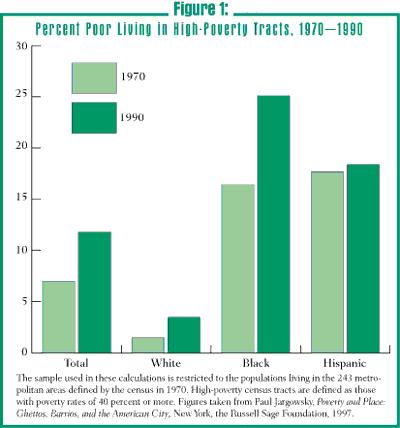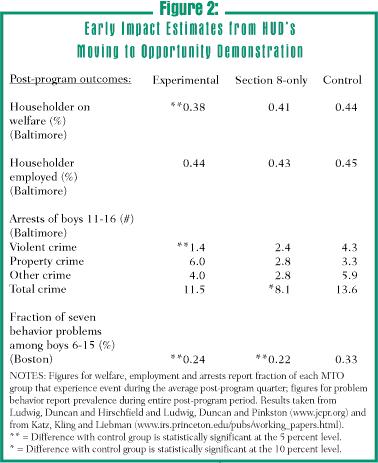Despite good news about recent trends in test scores, high-school completion, and crime rates, social problems among youth remain distressingly widespread in many urban areas. Conventional wisdom points to the violent and disorganized nature of inner-city neighborhoods and the poor quality of inner-city public schools as key causes of these problems.
This policy brief examines the results of an experiment aimed at dramatically improving the neighborhood conditions of children growing up in high-poverty, inner-city neighborhoods by offering families an opportunity to move to more affluent neighborhoods. The well-being of children in families offered such an opportunity is compared to that of otherwise similar children who did not move. Boys in the families that moved engaged in fewer problem behaviors and less crime than those who remained in public housing.
Trends in the concentration of poverty in the nation’s cities are not encouraging. Paul Jargowsky of the University of Texas at Dallas shows that from 1970 to 1990, the number of people living in high-poverty urban census tracts—defined as those with poverty rates of 40 percent or more—nearly doubled, from 4.1 to 8.0 million. If growing up in a high-poverty area compromises children’s development, then this burden falls most heavily on minority children. Figure 1 shows that the chance of living in high-poverty urban neighborhoods is a function of race as well as social class: some 3.5 percent of poor whites were living in high-poverty areas in 1990 as compared with 18.4 percent of poor hispanics and 25.1 percent of poor blacks.

A direct way of improving the neighborhood environments of poor children is through housing-mobility programs, such as the U.S. Department of Housing and Urban Development’s (HUD) Section 8 tenant-based rental subsidy programs. These Section 8 programs provide low-income families with a financial subsidy if they move to a private-market apartment or house that meets certain program requirements. While the specific subsidy formulas and other details vary a bit across the Section 8 programs, for simplicity we refer to this set of policies as “housing vouchers.”
Currently, around 1.6 million low-income families receive housing vouchers, nearly a ten-fold increase from the mid-1970s. Housing vouchers hold some appeal to both conservatives and liberals: they rely on the private market rather than the government to provide housing services to the poor, and at the same time improve housing quality for low-income families and provide them with greater choice over where they live.
Yet housing vouchers, and the increased residential mobility that they engender among poor families, are controversial. Residents of working- and middle-class neighborhoods fear that the arrival of low-income neighbors will lower property values and increase their own children’s social problems. And for some, the notion of government intervention to reduce economic residential segregation seems like “social engineering,” which violates their sense of fairness and may, in their view, reduce the incentives for poor families to work hard and improve their economic standing.
Do Neighborhoods Matter?
At the heart of many of these policy debates is a simple factual question: Can the changes in neighborhood environments generated by housing vouchers improve the developmental outcomes of poor children? To many people, the existence of such “neighborhood effects” is self-evident. Thirteen-year-old LeAlan Jones, who lived around the corner from the Ida B. Wells public housing projects in Chicago, thought the sudden change in his sister’s behavior could be traced directly to her peer group. As he notes in the book Our America: “She was in the spelling bee, she was in the Academic Olympics, she was the salutatorian of her class. Then she started hanging with these girls—their house was filthy, they were filthy—and they just kept dragging her down and down and down. She had a baby, starting staying out of school, started coming home late. But she chose her own path—let her walk it.”
Yet not everyone accepts the idea that neighborhoods or peer groups are important determinants of how children turn out. Some people believe that the family environment is ultimately responsible for most aspects of a child’s development. Others are convinced that much of what determines how children turn out is shaped by more complicated or idiosyncratic factors than family or neighborhood environments. For example, Northwestern University sociologist Mary Patillo McCoy, who grew up in a middle-class, African-American community in Milwaukee, writes: “Of my group of neighborhood and school friends, some had children young, were sporadically employed, or were lured into the drug trade, while others had gone on to college or worked steady jobs and earned enough to start a family. We started pretty much at the same place, but we ended up running the full gamut of outcomes.”
Because each of these arguments is plausible, sorting out the actual effects of neighborhood context on poor children requires empirical evidence. Yet this task is more complicated than it might initially appear.
Neighborhoods versus Families
There is very little debate among social scientists that family characteristics are highly predictive of how children will turn out. There is also widespread agreement that most families have at least some degree of choice over where they live. These two facts together make it surprisingly difficult to disentangle the effects of neighborhoods on children’s developmental outcomes from the effects of families. When we observe higher dropout rates for children living in high-poverty neighborhoods compared with those in more affluent areas, are these differences due to neighborhood factors, or instead to family factors that led some families to wind up in high- rather than low-poverty neighborhoods?
For many years, policy analysts have attempted to disentangle the effects of neighborhoods from the effects of family characteristics by using statistical methods to “control” for differences in observable family attributes. The results of these studies suggest that neighborhood factors are likely to play a surprisingly small role in affecting children’s outcomes. But because even the best social science data are unlikely to capture fully all of the family characteristics that matter for children’s outcomes, there remains the possibility that most or all of these studies confound family with neighborhood effects.
One of the most intriguing studies of how neighborhood conditions might affect the life chances of poor children was conducted by sociologist James Rosenbaum of Northwestern University, as reported in his book Crossing the Class and Color Lines (co-authored with Northwestern University law professor Leonard Rubinowitz). Rosenbaum followed Chicago public housing residents who were relocated to other parts of the metropolitan area as part of a court decision (Hills vs. Gautreaux, 425 U.S. 284, 306, 1976). The key to the Gautreaux program, as the relocation effort was known, was that most participants had little choice over where they moved. Families were placed on a waiting list for a new, private-market apartment, and if the family turned down the first available unit, they were moved to the bottom of the list. According to the administrators of the program, almost all families took the first apartment that was offered them.
Gautreaux thus generated a sample of Chicago public-housing residents who were essentially randomly assigned to both city and suburban neighborhoods. Since the family backgrounds of Gautreaux families living in different types of areas should on average be quite similar, comparing the outcomes of Gautreaux children whose families were assigned to different neighborhoods provided important evidence on the independent effects of neighborhoods. Analysis of the Gautreaux families suggested that compared with children who had moved to other parts of the city of Chicago, suburban movers had lower dropout rates (5 versus 20 percent) and were more likely to attend college (54 versus 21 percent).
Testing Gautreaux
The Gautreaux results are provocative: If millions of poor children in America start life disadvantaged by their neighborhoods, shouldn’t the government or private sector do something? Yet questions remained about whether the assignment of Gautreaux families to neighborhoods was actually random, and the use of survey data to measure outcomes inevitably raises questions about whether the surveyed families are truly representative of the full sample of participants. Nevertheless, the Gautreaux findings were sufficiently impressive to motivate HUD, under the stewardship of Secretary Jack Kemp, to fund a five-city demonstration project known as Moving to Opportunity (MTO) to formally test the Gautreaux hypothesis.
MTO was launched in 1994 in Baltimore, Boston, Chicago, Los Angeles, and New York. In each city, some 600 families with children living in public housing within these cities’ worst neighborhoods volunteered for the program, and were then randomly assigned to one of three groups. The first, “experimental,” group received housing vouchers that enabled them to relocate to private-market housing, but by the program’s design these subsidies could only be redeemed in very low-poverty neighborhoods (census tracts with poverty rates less than 10 percent). Families assigned to this experimental group also received services from a local non-profit that included counseling in basic life skills, such as how to negotiate a lease and balance a checkbook, and assistance in locating and renting an apartment.
Another group of families were randomly assigned to the “Section 8-only comparison” group. These families also received the offer to relocate to private-market housing, but under the conditions of the Section-8 program, which did not restrict their relocation choices to very low-poverty neighborhoods. Nor did this group receive additional counseling or relocation assistance. The remaining families were assigned to a “control” group that did not receive any assistance through the MTO program, but did not lose access to any services to which the family had been entitled previously.
Although most MTO families have only been in their new neighborhoods for three or four years, the initial data from the program are striking. Figure 2, based on research by economists Lawrence Katz, Jeffrey Kling, Jeffrey Liebman, and ourselves, compares differences in outcomes according to each family’s MTO assignment. The most dramatic differences across groups are those most directly relevant to the well-being of children.

There are striking differences across groups in criminal or problem behavior among adolescent males (the group responsible for most serious juvenile delinquency, and at highest risk for injury from such behavior). Parent-reported rates of problem behavior among boys in the experimental and Section 8-only group are one-third lower than among boys in control-group families, while the proportion of boys whose parents report that they are cruel towards others is three-quarters lower. Similarly, the arrest rate for violent crimes among experimental teens is only around one-third that of the control group. Nearly half of the difference in arrests for violent crime comes from robberies, which impose costs to society on the order of $8,000 per crime. The one less encouraging finding is that there may be an increase in property crimes among experimental teens. However, most of this increase comes from more larceny thefts, which by definition do not involve contact between the perpetrator and the victim (and thus entail no risk of injury to either party) and have average social costs of about $400.
These comparisons highlight the average effects on those families who were offered the chance to move through the MTO program. The actual effects on families who do move will be even larger than those shown in Figure 1, since not all families relocate through the MTO program. For example, in the Baltimore site, just over half of the families assigned to the experimental group relocated to low-poverty areas, while about three-quarters of those assigned to the Section 8-only comparison group moved through MTO.
More Residential Mobility?
Given the available evidence, what are the net effects of housing vouchers, and are such programs worthwhile? These questions are of more than academic interest. Since 1993, HUD’s Hope VI program has provided more than $3.7 billion in funding to 119 housing agencies in 32 states to demolish some of the country’s most notorious high-rise, public housing buildings. Some of the most visible demolitions have occurred in Chicago, with the destruction of a number of buildings in the Cabrini-Green projects on the west side of the city and the Robert Taylor Homes on the south side.
Housing agencies face pressing questions about how to provide housing services to the thousands of families who are displaced by these programs. Should we view a move from high-rise public housing to any other situation as an acceptable improvement? Or should cities make efforts to move displaced families into substantially higher quality neighborhoods? The question will grow in importance over time as these housing agencies face long-term questions about whether to invest resources in rehabilitating the rest of their public housing stock.
One problem with drawing inferences from the Gautreaux and MTO research is that because these programs are voluntary, the sample of families who participate may not be representative of all public housing residents. If those families who stand to gain the most from relocation are the ones most likely to volunteer for the program, then evidence from Gautreaux and MTO may overstate the gains from residential relocation that would be experienced by the typical public housing family. Nevertheless, our best guess is that expanding housing voucher programs to offer more public housing residents the opportunity to relocate would improve the life chances of a large number of poor children.
But there are limits to the effectiveness of any mobility program. Most important are the political constraints on any changes to current housing policies. Political considerations may mean that expansions of housing voucher programs must provide participants with the opportunity to relocate to whichever neighborhood they would like (like the MTO Section 8-comparison group), rather than coerce them into moving to neighborhoods with particular socioeconomic or demographic characteristics (like the MTO experimental group). Yet the consequences of this political constraint for the well-being of program participants may be minor. First, a larger proportion of participants are likely to actually relocate when their relocation decisions are unconstrained by the program design, as evidenced by data from MTO. Second, for the outcomes that bear most directly on children’s developmental outcomes, data from MTO suggest that the effects of offering families the chance to make a move unconstrained by the program design are, on average, fairly similar to those from the offer to relocate to very low-poverty areas. As seen in Figure 2, the average rates of teen violent arrest and problem behaviors are quite similar for families assigned to the experimental and the Section 8-only comparison groups.
The success of such a program will depend on a number of important design features. First, the programs should be voluntary, thereby limiting participation to those families who are motivated and believe they stand to gain from relocation. Second, the program should be limited in scope (at least for the near future). Reports from the field suggest that low-cost housing is scarce in many urban housing markets, which imposes a natural constraint on the scale of any program. Substantial expansions may also lead to the “clustering” of program participants within the same neighborhoods, which may have the effect of simply re-creating the poverty concentrations that characterized the public housing buildings from which families have moved. Moreover, the degree of political opposition to such a program will presumably be related to the number of families who are given the chance to relocate.
Such a program could improve the well-being of the poor families who participate. This fact alone, however, does not necessarily mean that housing vouchers are good public policy. Suppose, for example, that every child (regardless of family background) has the same response to neighborhood poverty rates. Redistributing poor families from high- to low-poverty neighborhoods would reduce the rates of social problems among the relocated children, but would produce offsetting increases in social problems among children in the host neighborhoods that are of the exact same magnitude. Residential mobility programs only work to reduce the overall volume of social problems in the society if disadvantaged children are more sensitive to neighborhood conditions than more affluent children. Alternatively, residential mobility programs may reduce the prevalence of social problems if there are “tipping points” in the ways that neighborhoods affect children’s outcomes, where “epidemics” of problem behavior only break out when the prevalence of social problems exceeds some cutoff level.
More generally, some consideration must be given to the costs of housing vouchers. The net financial costs to the overall housing budget may be relatively modest, since the cost difference to the government between rental subsidies and the direct provision of public housing units does not seem to be very large. The more important costs may stem from the program effects on the non-participants who live in both the original and new neighborhoods. The baseline public housing complexes could conceivably lose community leaders when housing-voucher programs are expanded. And, as noted above, there may be effects on host neighborhoods as well. Whether or not residential mobility programs reduce the overall volume of social problems within the society, they will presumably have the effect of redistributing problems from the central city to the suburbs.
The desirability of housing vouchers hinges on a number of factual questions, only some of which have been addressed by existing research. While even the best available evidence is somewhat limited, it suggests that moving very low-income families out of public housing and into more affluent neighborhoods may improve the well-being of poor children. Unfortunately, little is currently known about the effects of these moves on other residents in the original neighborhood or on children and adults in the receiving neighborhoods. Yet even when all of this factual evidence is available, overall judgments about whether such programs should be undertaken rest in large part on value questions that can only be answered through the political process.




